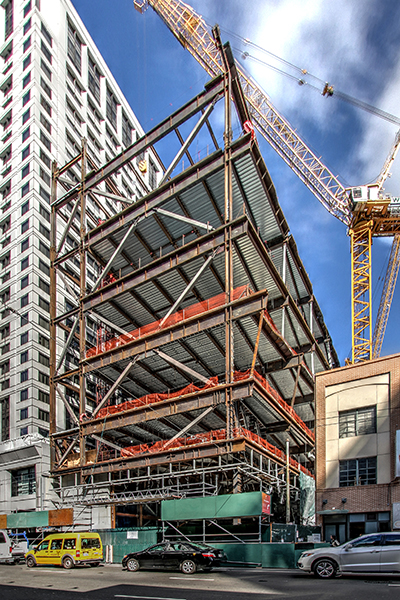 Options for the structural design of the San Francisco Museum of Modern Art (SFMOMA) expansion were constrained from the beginning.
Options for the structural design of the San Francisco Museum of Modern Art (SFMOMA) expansion were constrained from the beginning.
The unique site and foundation demands, along with compact architectural programming, limited possible structural strategies. However, in the end, these constraints sparked an innovative design using structural steel that met the economic and structural performance requirements, and helped make the largest modern art museum in the U.S. a resounding success.
The original SFMOMA, designed by Mario Botta/HOK (architect) and Forrell-Elsesser (structural engineer) in 1992, included a 4-ft, 6-in.-thick mat foundation. This foundation was extended beyond the footprint of the superstructure to allow for an expansion of similar height to the existing building, which is approximately 100 ft tall.
So when the design architect, Snøhetta, unveiled their vision for a 200-ft-tall tower nestled directly east of the existing building and spanning two blocks from Minna Street to Howard Street, it became apparent to the design team that the existing mat foundation would struggle to support the proposed structure. Accommodating a building twice the height of what was originally anticipated would require a 6-ft-deep mat foundation. However, demolishing the existing mat foundation would pose too great a risk for the existing building due to loss of flexural continuity, and the option of drilling large piles through the existing mat foundation was not economically feasible.
Therefore, the proposed solution was to retain the existing mat foundation and support the expansion on a series of full-story-deep concrete stiffening walls with embedded steel columns. The “egg crate” solution, as it was referred to by the design team, would create an occupied foundation or stiffened box—the existing mat foundation as the lower flange, the interior walls as stiffened webs and the grade-level slab as the upper flange. The walls would be positioned to spread load from the superstructure while still allowing for the architectural program within the basement.
The building incorporates 4,600 tons of structural steel, which was fabricated and erected by SME Steel Contractors, West Jordan, Utah (an AISC member and certified fabricator and erector).
For more about the project, see the article “Creative Arts” in our October issue (available now!).